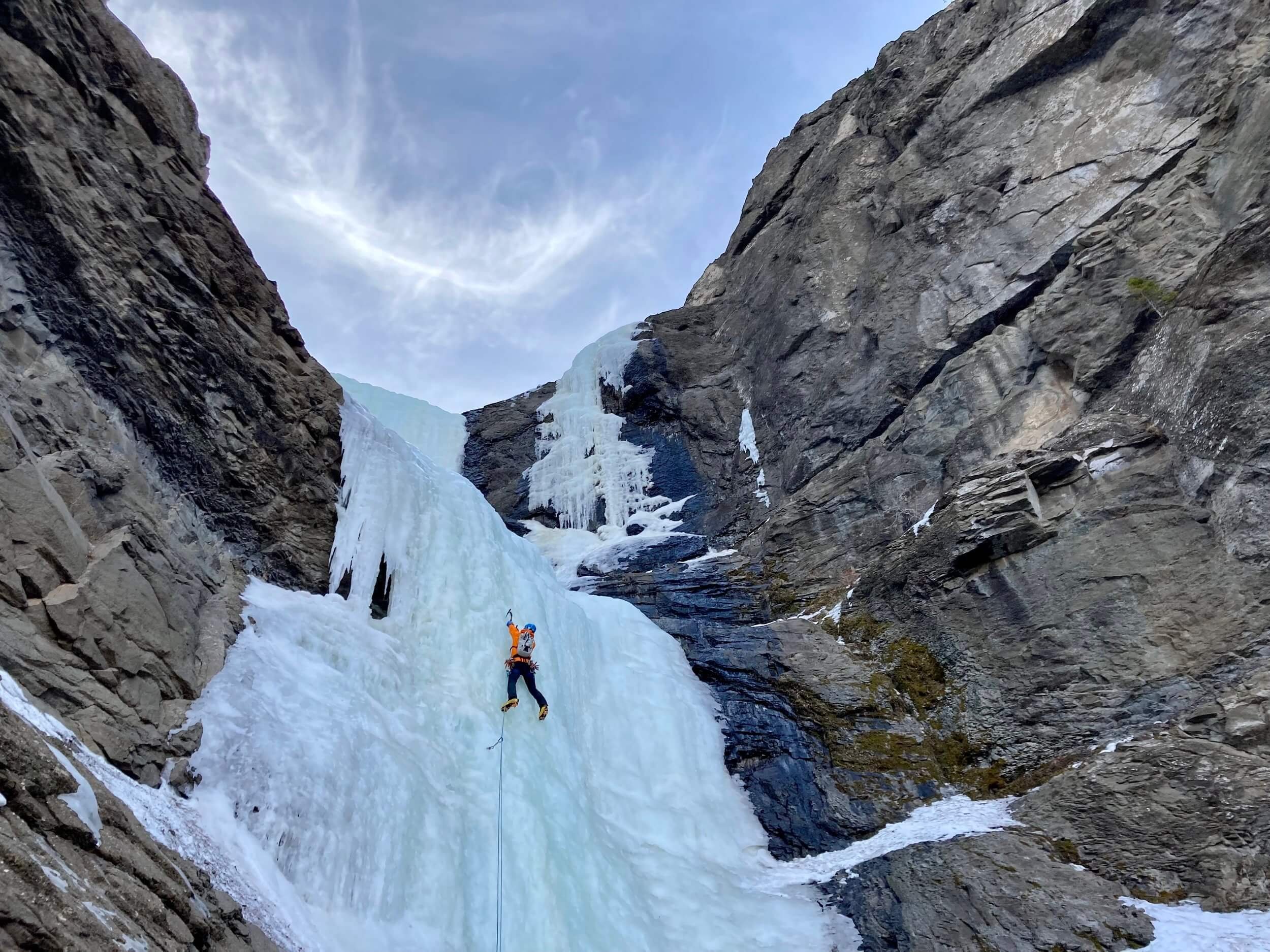
Learn to Lead Ice Climbing
The 3-day Learn to Lead Ice Climbing clinic is based primarily in the Ouray Ice Park where we can focus on instruction in a more controlled and accessible environment. We may also opt to go into the backcountry on the final day for application of the skills on a backcountry multi-pitch route.
Day 1: Review ice climbing movement techniques and top-rope a few pitches for a warm up and to provide instruction before launching into more complex leading topics. Cover foundational skills for leading ice in the afternoon.
Day 2: Mock leading in the morning to apply skills from the previous day and if appropriate, climbers will take the sharp end with a guide climbing nearby to actively coach along the way.
Day 3: This may take place at the Ouray Ice Park or a backcountry route in Silverton or Ouray backcountry, climbers will spend the day leading, building anchors, belaying followers from above and transitioning at stations on a multi-pitch route.
December 27 - 29, 2025
January 10 - 12, 2026
February 6 - 8, 2026
Previous ice climbing experience required, climbers should be comfortable top roping WI4-. No previous lead climbing experience is required.
Montrose Regional Airport is 45 minutes from Ouray. There is NO rideshare service, you may book a shuttle service or rent a vehicle with AWD/4WD (for winter driving).
There are plentiful hotels in downtown Ouray, conveniently located in walking distance to restaurants and the town hot springs for an aprés-climb relaxation.
Climbers are responsible for providing their own personal clothing and equipment. Skyward Mountaineering may assist in supplying technical equipment with advanced notice. See recommended equipment list below:
-
Underwear: Should be comfortable for a full day of activity, synthetic or merino wool will wick moisture away from the body
Heavyweight socks: Over-the-calf winter weight for superior warmth. Layering two pairs of socks is not recommended as it may impede blood flow and make your toes colder
Warm hat: Should be thin enough to fit under your helmet
Neck gaiter: Optional, lightweight and versatile for adding warmth around ears or covering your face in windy conditions
Softshell climbing gloves: Waterproof with high dexterity. 2 pairs recommended, one midweight and one heavyweight. Guide’s midweight recommendation - Showa Temres 282-02 (size up one from normal)
Mixed climbing gloves: Optional, these highly dexterous gloves have minimal insulation and are best for warmer days, lead climbing or mixed climbing
Midweight top baselayer: Merino wool or synthetic fibers will wick sweat away. Thumb loops are recommended to keep your wrists from being exposed and your hands warmer
Heavyweight bottom baselayer
Midweight fleece jacket: An integrated hood adds warmth and weather protection
Active insulation jacket: Ideal balance of breathability and warmth for winter aerobic activity
Midweight vest: Optional, adds warmth to your core without restricting movement
Softshell jacket: Midweight with a helmet compatible hood. Should have Durable Water Resistance (DWR) coating
Softshell pants: Midweight with reinforced instep. Avoid ski pants as they are often too baggy and likely to catch on your crampons
Insulated parka: Down is lighter/more compressible and a hydrophobic treated down will insulate even when wet. Should have at least 200 grams of 800 fill insulation
-
Climbing backpack: Approximately 30 liters with ice tool attachments
Mountaineering boots: Must be rigid with toe and heel welts for full crampon compatibility
Vertical frontpoint crampons: Dualpoints are better for continuous ice while monopoints are lighter and better suited for mixed climbing
Crampon pouch: Reusing a USPS Tyvek mailing package is a cost effective option, though specific manufactured options exist and are more durable
Technical ice tools: Remove any adze attachment as this may pose an unnecessary hazard for waterfall ice climbing
Climbing helmet: Must be UIAA certified
Harness: Recommended ice clipper compatibility
Tubular belay device with round bar stock locking carabiner
48 inch (120cm) sewn nylon sling: A Personal Anchor System (PAS) can be used instead, though is less versatile
1-2 Locking carabiners: Lightweight, screwgate is easier to operate than a triple-action carabiner
1-2 Non locking carabiners: Wiregates are less prone to freezing
2 Ice Clippers
Ice screws: Optional, these can be provided by your guide
8-12 Quickdraws: Optional, these can be provided by your guide. A mix of extendable and "sport" style quickdraws are used to connect the rope to the ice screw.
-
Sunglasses: Dimmable recommended, CAT 3 lenses w/ athletic fit
Small tube of sunscreen and SPF chap stick
First aid kit: Small, should include any personal medications
Hand warmers: Optional, for those colder days
Fully charged phone
1-2 liters of water: A thermos with your favorite hot drink is recommended. Avoid water bladders and hoses as they are prone to puncture and freezing in a winter environment
High energy lunch and snacks: A healthy mix of fats, sugar, and protein for a full day of the on-the-go (leftover pizza or sandwiches are a great midday pick-me-up)

Based on a 3-day itinerary with a minimum of 2 participants:
$990 per climber
Includes:
2 days of instructional climbing with an AMGA trained Guide
Group climbing equipment (ropes, ice protection and anchor material)
Does Not Include:
Additional expenses associated with a change in the itinerary
Transportation
Lodging
Meals
Guide gratuity






